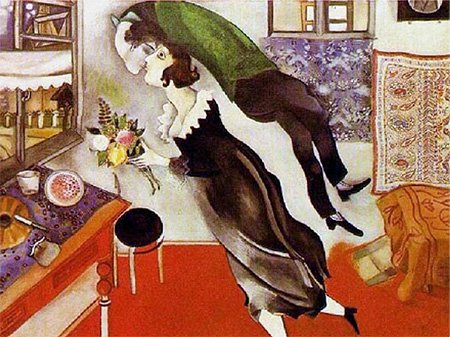Poem on Joy
Instructions
What brings you joy?
People? Places? Works of art? What uplifts you and causes you to be elated?
In this exercise, we will consider your source of joy and how to write a poem about it.
While you think for a moment, let's take a look at three samples of poetry, art, and music that are joyful of something.
Billy Collins's poem "Today," Marc Chagall's painting "Birthday," and Beethoven's "Ode to Joy" all contain some degree of joy.
In our exercise on the Image and Five Senses we found ways to evoke images in the mind of the reader by using concrete imagery of the five senses.
If we saturate our poem with imagery of the five senses (sight, sound, touch, taste, and smell), the reader may associate his own memories with those images, and if he does, our poem may begin to breathe and come alive in the reader's mind.
Let's see how one contemporary master, Billy Collins, does this.
As you view the video, imagine that you have been given the task of making an animation to accompany the author as he reads his poem. Would you make literal images in your video, or would you use figurative images?
Have a look, and then consider the list of images we have noted from the animation. If the image doesn't play, click the "low quality" button on the lower left, and press the "start" button.
This list of images which the animator has chosen to illustrate Collins's poem very closely parallels the text of the poem "Today."
- Butterflies and dandelion puffs
- Leafing trees
- Windows and doors open in house
- Dandelion puffs floating
- Bird cage door opens
- Canary flies out
- Cool brick path in garden
- Garden bursting with flowers
- Hammer enters and shatters paper weight
- Snow covered cottage breaks open
- Inhabitants in snow-covered cottage burst out
- Inhabitants fly from the room and out the window
- Inhabitants squint in sunlight
- Dandelion puffs drift in sunlit air
Along with the bird, both inhabitants in the room lift from the floor and fly out the window.
Interesting how, in his 1915 painting, Marc Chagall had much the same image in mind when he painted “Birthday.”

In your poem for this exercise, think from an animator's perspective. When you write your poem of joy to something, imagine that you are writing a script for an animation for your reader, and that the text of the poem is itself the script for the animation.
While the Collins video employs mostly visual images, you have the opportunity in your poem to include auditory, tactile, olfactory, and gustatory images.
In your poem of Joy, assemble and animate your images with as many of the five senses as possible; at minimum, use at least one of each.
For another view of joy and how it contrasts with despair, consider John Keats's Ode to a Nightingale.
Striking in this poem is the contrast between the speaker's great sense of despair and the sense of joy that he finds in the song of the nightingale.
Notice the many sensory images in the poem; here are a few:
- Of beechen green
- Cool'd a long age in the deep-delvèd earth,
- O for a beaker full of the warm South!
- Where palsy shakes a few, sad, last grey hairs,
In the following video, Leonard Bernstein introduces Beethoven's Ninth Symphony, the "Ode to Joy." He talks about Beethoven's spirit of innocence in a time of world agony.
As despairing as we may be "in this time of world agony and hopeless and helplessness, we love [Beethoven's] music and need it. As despairing as we may be, we cannot listen to this Ninth Symphony without emerging from it changed, enriched, encouraged."
In your poem to Joy, consider "celebrating" the birthday of poetry itself.
Perhaps by listening to this segment of Beethoven's Ninth Symphony while writing, you may find a path to your own source of joy.
Please write a poem to Joy, in fifteen lines or fewer, and submit it for consideration on the APW Forum/Guests' Pages. Email subject line: Joy Poem.
Enjoy!
